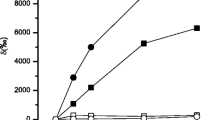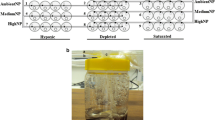Summary
The utilization of amino acids in leaf protein and leaf leachate by aquatic hyphomycetes was studied during decomposition in a combined field and laboratory experiment. Leaves were sampled from a stream which exhibited a seasonal variation in free amino acid concentration in surface water, reaching peaks in autumn and winter. In the leaf drift environment the concentration of amino acids was approximately two orders of magnitude higher than in surface water. Protein amino acid content, which was higher in alder leaves than in beech leaves, decreased exponentially and faster in alder leaves, so that protein amino acid content was similar in the two leaf types after 9–10 weeks decomposition. From 55% to 75% of leaf amino acids were used instantaneously by attached fungi, which grew well, especially on alder leaves, regardless of the presence of a grazing amphipod. If nitrogen was a limiting nutrient source for fungi, it appeared to be more advantageous to colonize alder leaves. Four times more fungal species were found on alder leaves than on beech leaves. The changes in concentration of amino acids in leaves and water was described by a set of differential equations. Rate constants for the transfer of amino acids from leaves and water were estimated from experimental data and the preference in fungi for protein-bound and free amino acids evaluated.
The amounts of free amino acids in water absorbed by fungi varied between leaf types and leaves at different stages of decay. Experimental data showed a switching behaviour in fungal absorption of dissolved amino acids so that absorption became superproportional at a certain proportion of free amino acids available in the water.
Similar content being viewed by others
References
Anderson JM (1973) The breakdown and decomposition of Sweet chestnut (Castanea sativa Mill.) and beech (Fagus sylvatica L.) leaf litter in two deciduous woodland soils. II. Changes in the carbon, hydrogen, nitrogen and polyphenol content. Oecologia (Berl) 12:275–288
Bååth E, Söderström BE (1977) Mycelial lengths and fungal biomasses in some Swedish coniferous forest soils, with special reference to a pine forest in central Sweden. Technical report 13, Swedish Coniferous Forest Project
Bärlocher F (1980) Leaf-eating invertebrates as competitors of aquatic hyphomycetes. Oecologia (Berl) 47:303–306
Bärlocher F, Kendrick B (1973) Fungi and food preferences of Gammarus pseudolimnaeus. Arch Hydrobiol 72:501–516
Bärlocher F, Kendrick B (1974) Dynamics of the fungal population on leaves in a stream. J Ecol 62:761–791
Bärlocher F, Kendrick B (1975) Assimilation efficiency of Gammarus pseudolimnaeus (Amphipoda) feeding on fungal mycelium or autumn-shed leaves. Oikos 26:55–59
Bengtsson G, Odham G (1979) A micromethod for the analysis of free amino acids by gas chromatography and its application to biological systems. Anal Biochem 92:426–443
Bent KJ, Morton AG (1964) Effects of external factors on the amino acid pool of Penicillium grisseofulvum. Biochem J 92:270–279
Clark NE, Jackson GA, North WJ (1972) Dissolved free amino acids in southern California coastal waters. Limnol Oceanogr 17:749–758
Cummins KW (1974) Structure and function of stream ecosystems. Bioscience 24:631–641
Cummins KW, Coffman WP, Roff PA (1966) Trophic relationships in a small woodland stream. Verh Int Verein Limnol 16:627–630
Dawson R, Prichard RG (1978) The determination of α-amino acids in seawater using a fluorometric analysis. Mar Chem 6:27–40
Fisher SG, and Likens GE (1972) Stream ecosystem: organic energy budget. Bioscience 22:33–35
Fisher SG, Likens GE (1973) Energy flow in Bear Brook, New Hampshire: An integrative approach to stream ecosystem metabolism. Ecol Monogr 43:421–439
Henrichs SM, and Farrington JW 1979. Amino acids in interstitial water of marine sediments. Nature 279:319–321
Howard PJA, and Howard DM (1973) Microbial decomposition of tree and shrub leaf litter. 1. Weight loss and chemical composition of decomposing litter. Oikos 25:341–352
Hultin L (1971) Upstream movements of Gammarus pulex (Amphipoda) in a South Swedish stream. Oikos 22:329–347
Hynes HBN (1970) The ecology of Running Waters. University of Toronto Press, Toronto
Iversen TM (1973) Decomposition of autumn-shed beech leaves in a spring brook and its significance for the fauna. Arch Hydrobiol 72:305–312
Jørgensen NOG (1979) Annual variation of dissolved free primary amines in estuarine water and sediment. Oecologia (Berl) 40:207–217
Kaushik NK, and Hynes HBN (1968) Experimental study on the role of autumn-shed leaves in aquatic environments. J Ecol 56:229–243
Kaushik NK, and Hynes HBN (1971) The fate of the dead leaves that fall into streams. Arch Hydrobiol 68:465–515
King HGC, and Heath GW (1967) The chemical analysis of small samples of leaf material and the relationship between the disappearance and composition of leaves. Pedobiologia 7:192–197
Kostalos M, and Seymour RL (1976) Role of microbial enriched detritus in the nutrition of Gammarus minus (Amphipoda). Oikos 27:512–516
Lawton JH, Beddington JR, and Bonser R (1974) Switching in invertebrate predators. In: Usher MB, Williams MH (eds) Ecological Stability. Chapman & Hall, London
MacArthur R (1972) Geographical ecology, Patterns in the distribution of species. Harper & Row, New York
Minshall GW (1967) Role of allochthonous detritus in the trophic structure of a woodland springbrook community. Ecology 48:139–149
Murdoch WW (1969) Switching in general predators: experiments on predator specificity and stability of prey populations. Ecol Monogr 39:335–354
Murdoch WW, Avery S, and Smyth MEB (1975) Switching in predatory fish. Ecology 56:1094–1105
Nykvist N (1963) Leaching and decomposition of water-soluble organic substances from different types of leaf and needle litter. Stud For Suec 3:3–29
Petersen RC, and Cummins KW (1974) Leaf processing in a woodland stream. Freshwater Biol 4:343–368
Pianka ER (1970) On r-and K-selection. Am Nat 104:592–597
Sanders PF, and Anderson JM (1979) Colonization of wood blocks by aquatic hyphomycetes. Trans Br Mycol Soc 73:103–107
Schell DM (1974) Uptake and regeneration of free amino acids in marine waters of Southeast Alaska. Limnol Oceanogr 19:260–270
Suberkropp K, and Klug MJ (1976) Fungi and bacteria associated with leaves during processing in a woodland stream. Ecology 57:707–719
Suberkropp K, Godshalk GL, and Klug MJ (1976) Changes in the chemical composition of leaves during processing in a woodland stream. Ecology 57:720–727
Triska FJ, Sedell JR, and Buckley B (1975) The processing of conifer and hardwood leaves in two coniferous forest streams: II. Biochemical and nutrient changes. Verh Int Verein Limnol 19:1628–1639
Webster J (1969) Experiments with spores of aquatic hyphomycetes. I. Sedimentation and impaction on smooth surfaces. Ann Bot NS 23:595–611
Wetzel RG, and Manny BA (1972) Decomposition of dissolved organic carbon and nitrogen compounds from leaves in an experimental hard-water stream. Limnol Oceanogr 17:927–931
Author information
Authors and Affiliations
Rights and permissions
About this article
Cite this article
Bengtsson, G. Patterns of amino acid utilization by aquatic hyphomycetes. Oecologia 55, 355–363 (1982). https://doi.org/10.1007/BF00376923
Received:
Issue Date:
DOI: https://doi.org/10.1007/BF00376923




